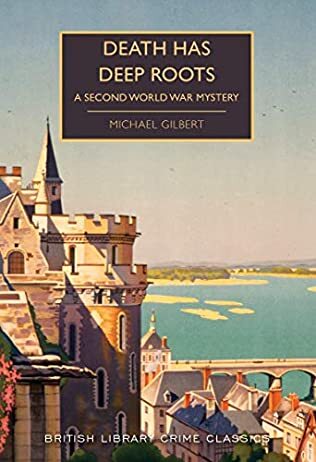Death Has Deep Roots

A review of Death Has Deep Roots by Michael Gilbert – 230523
Although sub-titles “A Second World War Mystery”, Death Has Deep Roots, the fifth novel written by Michael Gilbert and originally published in 1951 and reissued as part of the British Library Crime Classics series, is actually set about three years after the end of the war. The roots of the murder mystery, though, are to be found in an event that occurred in occupied France during the war. The structure of the book is interesting, part court room drama, part investigation with the jeopardy of only having a short period of time to find the evidence that could prevent a grievous miscarriage of justice.
Taxonomically included in Gilbert’s Inspector Hazlerigg series, the doughty officer of the Yard only appears on a couple of occasions, once near the beginning and the other at the end. Much of the investigative work is carries out by the son of Victoria Lamartine’s newly appointed lawyer, Nap Rumbold, and Major Angus McCann, Nap taking the French leg and McCann rooting around in England. Both, in their different ways, help to put the pieces together to solve what boils down to a very logical and straightforward crime, where the underlying motivation is to keep one’s enemies close to you and strike to obliterate any possibility of a dastardly war crime being discovered.
Victoria Lamartine is on trial for her life, accused of killing Major Eric Thoseby, who was staying as a guest at The Family Hotel near Euston, where she was working as a chambermaid, a job that had been found for her by the authorities as part of the resettlement of members of the French resistance. Thoseby was found stabbed to death in his room, the style of killing straight out of the resistance’s textbook and with Lamartine found on the scene and her fingerprints on the knife. She sacks her legal advisers who want her to plead guilty and the reader is left with the sense that she is probably the victim of a set up. However, will the grinding wheels of justice be stopped in time to reprieve her?
The best part of the book is Rumbold’s investigations in the Angers region of France. Gilbert does a good job in recreating the atmosphere of fear and suspicion that prevailed at the time, everyone having a secret from their past, either wanting to exaggerate or hide their actions during the occupation, people disappearing, no one quite sure who anyone is, who was on the right side and who was a collaborator. Rumbold, somewhat of an innocent abroad, blunders into this web of suspicion and is lucky to escape with his life. Nevertheless, he begins to realise that Lamartine, who was captured by the Germans, had been set up by the same people not just once in France but for a second time in London.
McCann’s investigations are more prosaic, but he manages to unearth the missing link that proves to be the key to the mystery. Much also hangs on why there was a delay in calling for a doctor after the Thoseby’s body was discovered, the positioning of the fingerprints relative to the grip required to strike the fatal blow, and the precise timings of the movements of the key individuals.
Gilbert writes with some humour and the court scenes, drawing on his legal background, are light and capture the repartee that often exists between the counsels so that they are not as dry as they could be. The three strands of the book interweave well – it reads a bit like a TV programme with constant flashbacks – but I got the sense that it was a mechanism to hide the fact that the mystery was rather bland and not very complex.



